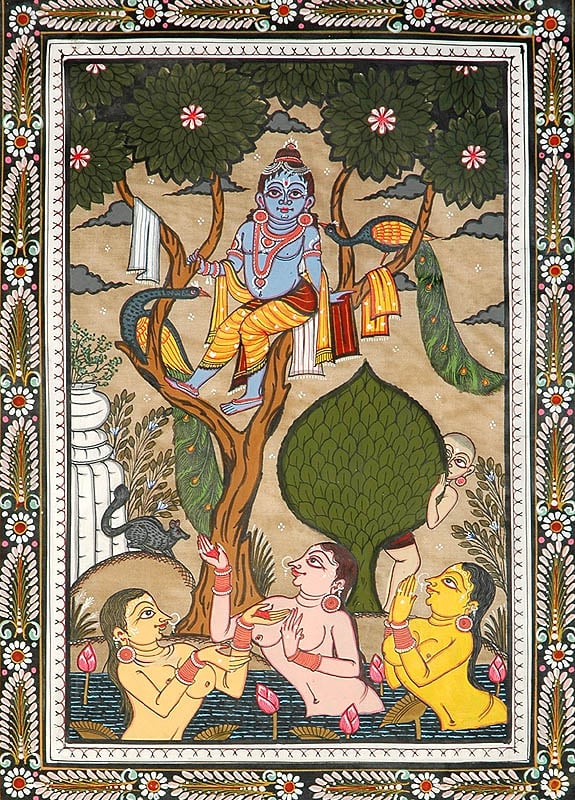GITA 4.28
We are at Chir Ghat,on the banks of Yamuna, the spot where Sri Krishna as a boy teased gopikas.This is near Kosi on the Delhi- Agra highway. The gopikas went for bathing in Yamuna. They removed all their dresses and bathed naked. Sri Krishna wanted to teach them and so He hid all their dresses on the nearby tree branches. Gopikas finding their dresses not on the shore, found Sri Krishna sitting on the branch of the tree.
They prayed Him to give back their dresses. He wanted them to salute Him. They did with one hand and the other hand was used to hide their modesty. But He did not accept it, as saluting with single hand was against shastras. Then they tried to combine two girls' hands to make one folded namaskar and the other hand of each of them to cover their modesty. Sri Andal says that gyana is our garment and that only will give the person respect. If this garment is lost, then we are in the samsara ocean and we are haunted by the five organs acting as sharks. In this situation we pray the Lord to give us Gyana or the garment to protect us from the sharks. This spot is called chira haran [ dress grabbing]. Later, Sri Krishna gave back their dresses and they also went home.
We will now go to the 26th sloka. In the 21st, 22nd and 23rd slokas, Sri Krishna advised Arjuna to view Karma as Gyana and vice versa. In the 24th sloka, He said that a Karma yogi views all the havis, the agni, himself and the ladles used, as Brahman. From 25h to 29th slokas, He describes various types and one could choose anyone. In the 25th sloka two types were described: one performing pooja to God's idol and the other performing homam or yagna using sacred fire. Here, we should not think that the first type is superior to others. All are equal and yield the same result. Now in the 26th sloka and in the first half of 27th sloka, He describes three types of Karma yogis. Now 26th sloka:
srotradinindriyany anye
samyamagnisu juhvati
shabdadin visayan anya
indriyagnisu juhvati
samyamagnisu juhvati
shabdadin visayan anya
indriyagnisu juhvati
Some of them sacrifice the hearing process and the senses in the fire of the controlled mind, and others sacrifice the objects of the senses, such as sound, in the fire of sacrifice.
"Some [karma yogis] sacrifice the hearing process and the senses in the fire of mental control, and others sacrifice the objects of the senses in the fire of the senses."
Here also a type of yagna is mentioned, but there is no fire or actual havis to be offered. We are to imagine certain things here. Srotradindriyay = sensual organs like ears, anye = another type of Karma yogi, juhvati = offers into, samyam = control of senses, agnisu = fires like. There is no actual fire but we have to imagine control of sensual organs as the fire. In an yagna, havis are offered into the fire. Here, this Karma yogi offers, the sensual organs into this imaginary fire of control of senses. This way his senses do not drift. Here plural is used in the word fire. Because each sensual organ requires separate sense control and so we can imagine five 'fires' for the five senses. In the next type we have to imagine the sense organs as agni or fire. Shabdadi vishayan = sensual experience like listening, are, juhvati = offered into, indriyagnisu= the sense organs [fires], anya = by yet another type of Karma yogi. All the sensual experience like listening, tasting, etc., are offered into their respective organs. This means those organs destroy those experiences like fire destroys the havis offered. There is a shastra that, of all the things to be controlled, the prime is control of sense organs. The organs are with us in our control. But the objects for these senses are outside us, and they are not in our control. In the second type, therefore, the Karma yogi avoids all those outside him which could cause sensual attractions in him. If we know a place for gambling, we avoid that, and this is the second type mentioned in this sloka. In the first type, since this Karma yogi has already got control of senses, these external objects do not disturb him. This way Sri Krishna mentions the 3rd and 4th types of Karma yogi.
(continued)


No comments:
Post a Comment